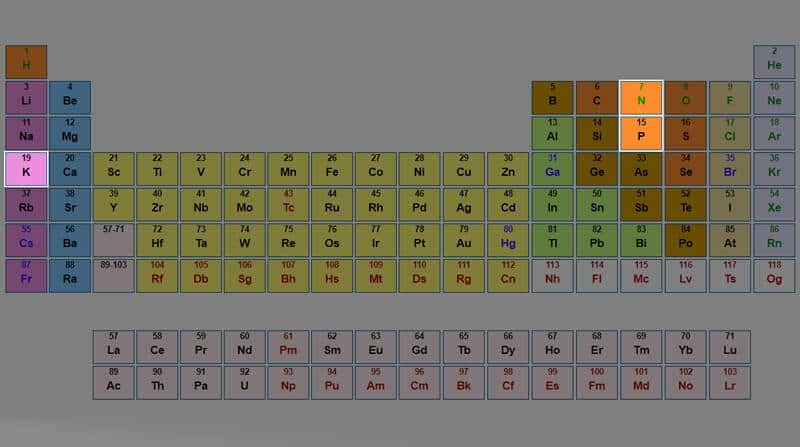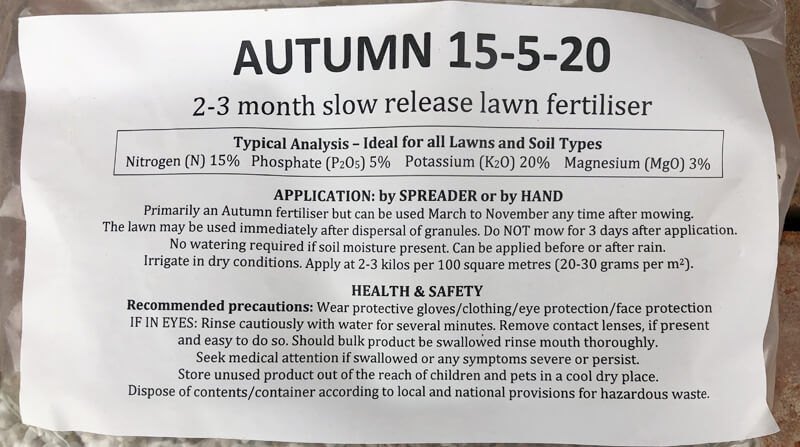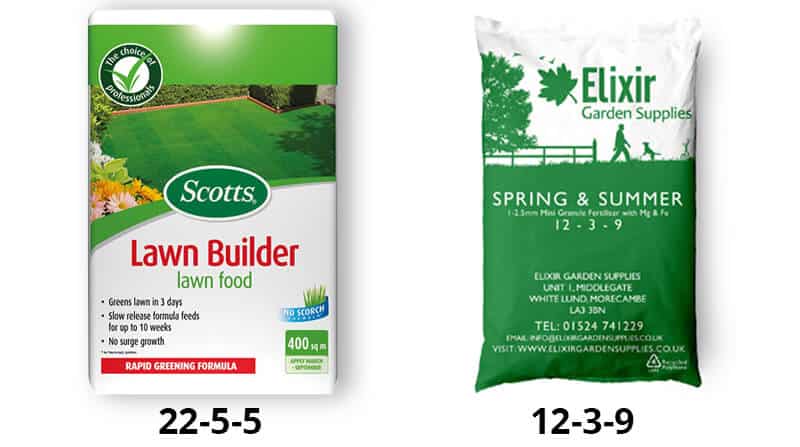If you’relooking online for the best grass feed whether it be liquid lawn feed or a granular product, then chances are you’ve been confused by NPK values.
Numbers like 18-3-8 and 15-5-20 and any of the other hundreds of combinations can be pretty baffling.
So what does NPK stand for and what does it all mean?
How to Understand Grass Feed Labels
Oftentimes people get confused when looking at the labels on lawn fertiliser products. The big numbers and words like ‘typical analysis’ all sound a bit technical.
In fact, they’re very simple to understand.
What Does NPK Mean?

When you look at lawn fertiliser you’ll the letter N, P and K.
- N represents Nitrogen
- P represents Phosphate, and
- K represents Potassium
Nitrogen, Phosphate and Potassium are essential elements for lawn health and vigour.
The letters simply represent the elements on the periodic table.
What Do the Numbers Mean?

There are normally 3 numbers on a bag of fertiliser. These numbers explain how much NPK the product contains.
For example, on the label above the number looks like this: 15-5-20.
The first number (15) is the Nitrogen (N) content. The second (5) is the Phosphate (P) content and the third number (20) is the Potassium (K) content.
If you look at the Typical Analysis information you will notice that these numbers represent the percentage of the bag’s content;
- Nitrogen (N): 15% or 15 grams in every 100
- Phosphate (P): 5% or 5 grams in every 100
- Potassium (K): 20% or 20 grams in every 100
If you add 15% to 5% and 20% you get 40%, or 40g in every 100. So what’s in the other 60%?
In the product above, when you look again at the typical analysis, you’ll see that this particular fertiliser also contains 3% Magnesium, or, 3 grams in every 100.
So now where’s the other 57%?
Well, if you think about it, Nitrogen is a gas so it’s not just made up of Nitrogen. If it was it would escape. So it comes in the form of a chemical compound, usually a salt (also known as Potash) which sometimes has a slow-release coating.
Some lawn fertilisers also include organic matter to help improve the soil, secondary nutrients like Calcium, Magnesium, and Sulphur, as well as trace elements which, when added up, make the 100%.
Why NPK is So Important For Grass
NPK, or Nitrogen, Phosphate and Potassium are essential for the health and vigour of your lawn.
- Nitrogen is mostly responsible for cell formation and growth
- Phosphate predominantly aids root development
- Potassium helps the plant function and increases tolerance to drought and cold
Grass Needs Different Amounts Of NPK At Different Times Of Year
Depending on the time of year, grass needs different amounts of NPK.
For example, during the spring when grass grows vigorously, it needs more Nitrogen to support new cell formation and growth.
However, during the winter, grass growth slows right down so the need for Nitrogen (N) is much less. What it does need, is more Potassium (K) to keep functioning and to harden it against the cold and wet. Some winter feeds also contain Iron (FE) which is the primary ingredient in moss killer. This acts ats a turf hardener and helps keep moss at bay.
Why Do NPK Values Vary So Much Between Different Brands?
When you look at different brands of lawn feed, you’ll notice the NPK values vary. Sometimes quite dramatically.
Let’s take Scotts Lawn Builder and Elixir Garden Supplies for example.

Both are spring/summer fertilisers and both are made for the domestic market. However, the NPK values vary quite significantly, especially the Nitrogen value.
Why is this?
Well, it comes down to how often you apply the product.
Scotts Lawn Builder is a slow-release fertiliser which feeds your lawn for up to 10-12 weeks. It contains more Nitrogen but it doesn’t get released into the ground all at once.
On the other hand, the Elixir Gardens lawn feed is a much faster acting product and only feeds your lawn for up to 4 weeks. If this was to contain the same amount of Nitrogen as Scotts Lawn Builder, it would cause your grass to grow much quicker than it should.
This is called growth surge and can cause a lot of stress to the plant. It’ll also cause excessive thatch build-up which means you’ll have to scarify more often.
So Which Should You Use?
For most gardeners, I’d choose the Scotts Lawn Builder over the Elixir product.
Here’s why;
Firstly, because you only need to feed the lawn once in a 12 week period as opposed to 3 times. So it’s less work.
Secondly, by feeding your lawn every 4 weeks over the course of a season, you’ll apply more Nitrogen than you need. Despite the Nitrogen content only being 12%.
This will result in surge growth, stressed grass and excess lawn thatch.
A Quick Note About Nitrogen Levels in Domestic Grass Feed
As you now know, it’s mainly the Nitrogen content in grass feed which causes the grass to grow.
Most domestic lawn feed products contain more Nitrogen than is necessary for healthy growth.
This is because manufacturers want to show their customers quick results with fast growth and greener grass.
However, the over-application of Nitrogen can cause stress to the grass plants, especially in hot, dry conditions.
So always be careful about how much fertiliser you apply and how often you apply it. Especially spring/summer fertilisers which contain higher levels of Nitrogen.
It’s definitely better to apply less than the recommended dose than apply more so always air on the side of caution.
In Conclusion
If you let it, fertilising your lawn can become very complicated very quickly.
So I hope this article has helped you get to grips with what all the information on grass feed labels mean.
To keep things really simple, manufacturers create spring/summer feeds and autumn/winter feeds. This means you don’t have to worry about applying too much or not enough NPK at different times of the year.
This article also explains my lawn feeding schedule which will help you to know when and how often to fertilise the grass. And in order to get the most out of your fertiliser products, learn how to apply granular feeds and how to spray liquid grass food.
But it’s worth repeating, it’s always best to slightly underfeed your lawn than it is to overfeed it!
